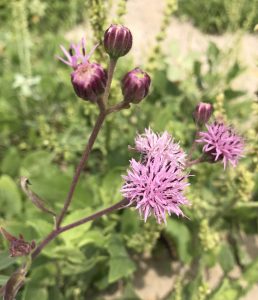by Eileen Mattei

Many new TMNs shy away from the Latin names of plants. I remember whining, “Why can’t we use the common name for this? I don’t know how to pronounce that.” During the 2020 TMN Virtual Conference, Carol Clark introduced us to “Just Enough Latin to go Plant Shopping.” She demonstrated that binomial nomenclature (Latin names) help to confirm a plant’s identification. If we calm down a moment and look at the Latin word, we often get clues to what the name means. It often is similar to an English word.
But why Latin instead of common names? By using Genus (always capitalized) and species (never capitalized), we avoid confusion when talking about a plant. One tree has 13 common names; 30 plants are called buttercups. Loosestrife is both a native and a different invasive. Knowing the right name lets you avoid mistakes and can save you time and money.
Botanical Latin “is a hodgepodge that doesn’t follow exact Latin. We bend the rules all over the place,” Clark said. Yes, that makes it hard to figure out how to pronounce names, but just give it your best shot. After all, various fields (academic, church, etc.) use different pronunciations, anyway.
Really, you will soon get a feel for it. For instance, the sage, Salvia greggii. The double ii is common in Latin names. The first ‘i’ is pronounced eee, the second as eye. greg-eee-eye.
Many plants are named to honor a botanist, a patron or a friend, which do nothing to help you when you’re identifying a plant. But usually clues abound in the binomial, telling you about its color, its shape, its smell, its form, its habitat, its area of origin or its seasonal attributes.
More than 100 color names are used, and some you will find familiar. Azurea and cerulea are blues, argenta is silver, alba is white. Rubra and coccinea are reds.

For forms, pendula refers to a weeping habit, while prostrata means lying down. Plants labeled humilis are low lying (think pigeon berry, Rivina humilis) while scandens is climber, a vine. A plant you find in the forest may have sylvatica in its name, while a plant in an area that floods may be have fluvialis in its name. You can guess where a plant labeled montanus will be found. Rivina humilis Pigeonberry
Australis is southern, while borealis is northern. Orientalis is eastern, occidentalis is western.
And Texana?
Bad-smelling plants might have foetida or horrida in their name, while fragrantissima plants will be wonderfully fragrant, not merely suavis, or sweet. Or the name might include citri– for its citrus scent.
Timing might be everything for your focus plant: hibernalis refers to winter, praecoxmeans flowering earlier than most, virensis evergreen and nocturna is night-blooming.

Of course, plant parts are described as well, with words like folia (leaf), carpus(fruit), canthus (thorn.) Size and number are frequently included in the binomial. Macro is large (macrocarpa means big seeds) and gigantean is huge. Next come shapes. Ovata is oval-shaped, tenuis is thin, and undulata is wavy.
Other descriptive names are gracilis (slender), lucida (shining), punctata (with dots), glandulosa (sticky glands), and recta (upright.)

As you start to recognize the meaning of the Latin names and pair the names with a plant, the use of binomials will make sense.
Soon you will be dropping names like Caesalpinia pulcherrima, Callicarpa americana, and Egreta rufescens (reddish egret.)
Great post Anita! We need a cheat sheet card we can carry with us when purchasing plants!